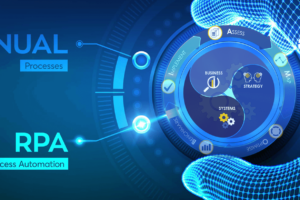Featured in the Spring 2022 Edition of the World Leasing Review.
Digital transformation, moving from paper and manual processes to paperless, interactive and automated processes, has been put forward as the holy grail for productivity and efficiency for decades. However, in the last five to ten years, the technology, especially the accessibility to those without technical backgrounds, has improved immensely. These tools are now easy to learn and simple to configure with drag-and-drop functionality, and many organisations can implement and configure robotics software with skills they already have in-house. The development of artificial intelligence solutions to robotise processes means we are now closer to realising the potential of this type of business transformation than we have ever been. Gartner predicted that the worldwide market for the technology that enables hyperautomation would reach $596.6 billion in 2022. Hyperautomation (a term coined by the same research firm in 2019), broadly referred to as Intelligent Process Automation (IPA), describes the combination of technologies like Artificial Intelligence (AI), Machine Learning (ML), Robotic Process Automation (RPA) and no/low-code workflow tools integrated into enterprise software platforms to achieve process excellence and put automation into action.
No more clunky screen-scraping. No more complex coding solutions or disparate applications unable to communicate and integrate with each other, leading to manual process bottlenecks. Automation tools that allow focus on more strategic tasks provide enhanced insight and help organisations navigate today’s changing and complex operating environment. A workforce used to collaboration and digital transformation in their social and personal financial lives is now better adapted to social collaboration within their business life.

Always online and accessible, with declarative tools to allow the end-users to model, design and implement automation of their processes with minimal technical knowledge or IT department interaction; content service solutions to manage documentation, decision-making and approval without any paper copies in sight, the new breed of business process management and robotic process automation platforms are rightly able to call themselves digital transformation.
Organisations are increasing investments in financial process automation to enable more robust business processes that support external and internal business needs. Whether coming from a process modelling base and moving into process automation, or coming from a robotic process automation base and providing workflow tools, many similar providers are moving into the digital workplace space. Unsurprisingly, the automation market is growing quickly, given its many potential benefits. This brings with it a dilemma, of course – how to differentiate between the many providers of these platforms and identify which will be best suited to your business? Many application platforms contain or provide their own process automation tools, such as Salesforce, Microsoft and Oracle. Standalone digital workflow providers range from open-source solutions like Camunda BPM through to industry heavyweights like Automation Anywhere, Laserfiche, Processmaker, Blueprism, UI Path and Nintex. All these solutions share a common feature set:
• Native process modelling capability, often supporting the BPMN 2.0 process modelling standard.
• No to low code declarative design and implementation tools to enable non-technical users to build applications, forms and workflows which can be quickly deployed without involvement by the IT department.
• Always-available cloud access via a browser or access via on-premise servers.
• Native APIs and tools to connect to most major CRM and ERP providers, including Salesforce, Oracle and SAP, enabling cross-application automation.
• Capability to robotise processes; populating data without human intervention.
They are also all eager to highlight the flexibility of their solutions, allowing you to invest only in the elements that suit your need and then build up to full automation solutions or integrations as required. However, that somewhat negates the unique selling point of these platforms, which is to act as an overall digital workplace where all your disparate processes and applications can be unified, optimised and, where applicable, automated to free up your human resource to focus on your own company’s USP, whatever that may be.

Regardless of the specific technology an organisation will use to automate or streamline a process, what is needed is an understanding of all the steps involved in that process, and many organisations lack full visibility because steps are happening in siloes. Carefully consider the impact automation will have on your process and where the human touch remains the best approach. Process teams will always be required to provide the business process expertise necessary for pipeline identifications, robotics configuration and deployment, and sometimes monitoring and ownership of the robotics automation.
At VIP Apps consulting we use our AMOBI methodology to map and optimise business processes. AMOBI is an iterative framework based on the concept of continuous improvement. It enables a structured, templated approach to assess initial requirements using root cause assessment, mapping, and optimising processes to identify manual or system bottlenecks, comparing the proposed optimisations to the expected benchmark and implementing successful optimisations. The AMOBI stages are: Assess, Map, Optimise, Benchmark and Implement.

Many people take the objectives of digital transformation as axiomatic. After all, who would argue against removing repetitive manual tasks from their business processes, allowing their workforce to use their full skill set in promoting and expanding the business rather than pushing buttons or printing documents? Therein lies a paradox, though, as often the expertise of your workforce is also in which button to push and which document to manage. Before diving into the more specific details of the automation, it’s crucial to determine the ‘why’ for automation and its purpose. An early assessment will force you to take a more holistic approach to the implications and impact of automation on the organisation. Ask questions! What does automation mean to our organisation? What business outcomes do we want to achieve? Ask what the people’s roles and tasks are, and learn what processes are undertaken and the issues they face. For example, consider aspects like the volume of keystrokes required to carry out those tasks and the time needed. Analyse what applications are being used. These questions will help you uncover essential information to set measurable and realistic goals and address the culture side of these projects, the resistance to change. To address the lack of understanding and fear of embracing a new system, have a robust change management plan to upskill and train staff to feel confident in a completely digital environment. This holistic assessment will help identify where automation can be more beneficial and what software and solution will result in the greatest efficiency. Optimising your business processes with automation can create better business models and eliminate process inefficiencies and even result in business transformation. But training robotic software to achieve what the best human software does naturally is not an easy task. Despite rapid advancements in artificial intelligence algorithms, there are still some processes where the human touch can be the difference between a happy customer and a lost customer.
So, as with any business endeavour, digital transformation should not be approached just as a means to an end or as the latest must-have piece of technology, but as an extension of the normal continuous improvement practices that should underpin your business. Whether you use digital platforms to empower your workforce to lead change, or employ process assessment experts like VIP Apps Consulting, regular evaluation of your business processes to identify inefficiencies and bottlenecks will identify the prime candidates for effective digital transformation and help you narrow down the requirements for your chosen platform, allowing you to invest in innovative technologies whilst maximising value. In the current climate, improving your own efficiencies and value base, whilst allowing your teams to focus on the differentiators that are uniquely provided by human touch, will not only help now but build a robust platform for the future.
References:
https://www.gartner.com/en/newsroom/press-releases/2021-04-28-gartner-forecasts-worldwide-hyperautomation-enabling-software-market-to-reach-nearly-600-billion-by-2022.
https://vipappsconsulting.com/insights/3-steps-to-building-a-successful-process-automation-strategy/.
https://www.mckinsey.com/business-functions/mckinsey-digital/our-insights/intelligent-process-automation-the-engine-at-the-core-of-the-next-generation-operating-model.









